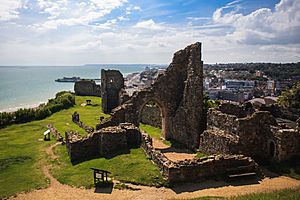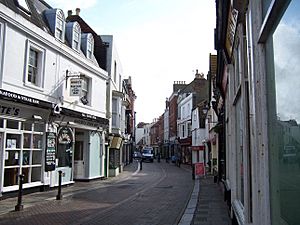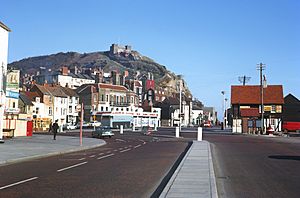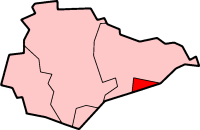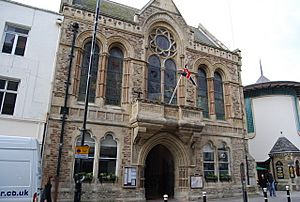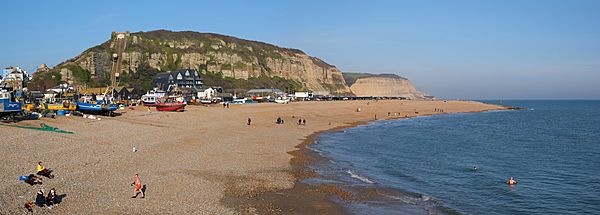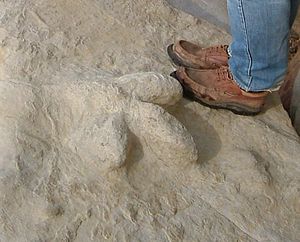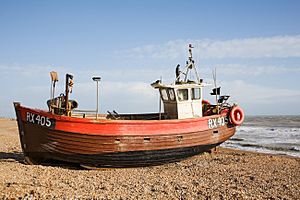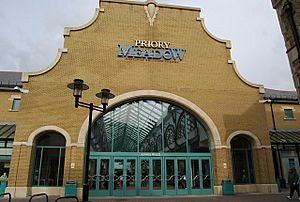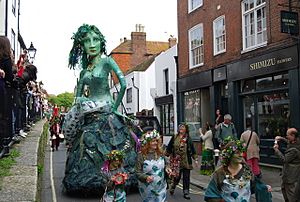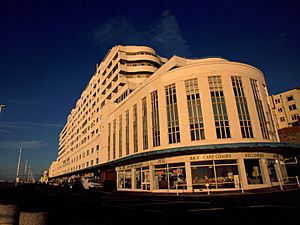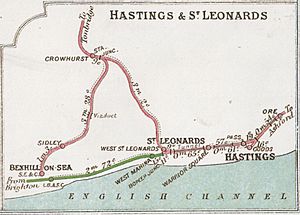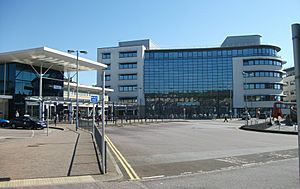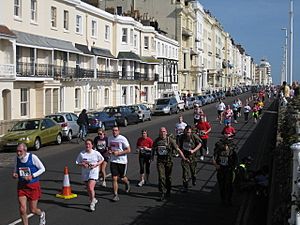Hastings facts for kids
Quick facts for kids
Hastings
Borough of Hastings
|
||
|---|---|---|
| Hastings | ||

View of Hastings Old Town from the East Hill
|
||
|
||
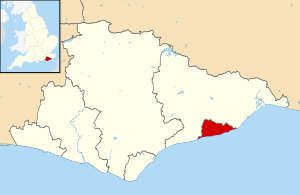
Borough of Hastings shown within East Sussex
|
||
| Sovereign state | United Kingdom | |
| Constituent country | England | |
| Region | South East England | |
| Historic county | Sussex | |
| Ceremonial county | East Sussex | |
| Status | Non-metropolitan district | |
| Area | ||
| • Total | 11.47 sq mi (29.72 km2) | |
| Area rank | 301st (of 326) | |
| Population
(2018)
|
||
| • Total | 92,855 | |
| • Rank | 261st (of 326) | |
| • Density | 9,000/sq mi (3,300/km2) | |
| Ethnicity (2021) | ||
| • Ethnic groups |
List
|
|
| Religion (2021) | ||
| • Religion |
List
51.4% no religion
37.8% Christianity 6.6% not stated 1.9% Islam 0.9% other 0.6% Buddhism 0.5% Hinduism 0.2% Judaism 0.1% Sikhism |
|
| Time zone | UTC0 (GMT) | |
| • Summer (DST) | UTC+1 (BST) | |
| Postcodes |
TN34–35
|
|
| Area code(s) | 01424 | |
| Website | Hastings Borough Council at | |
Hastings (/ˈheɪstɪŋz/ HAY-stingz) is a lively seaside town in East Sussex, England. It's located on the south coast, about 24 km east of Lewes and 53 km south-east of London. The town is famous for the Battle of Hastings, which happened nearby in 1066.
Hastings was once one of the important medieval Cinque Ports. In the 1800s, it became a very popular seaside resort thanks to the arrival of the railway. Today, it's still a popular spot for visitors. It also has the UK's largest fishing fleet that launches directly from the beach. In 2021, about 91,100 people lived in Hastings.
Contents
- Discovering Hastings' Past
- How Hastings is Governed
- Hastings' Location and Weather
- Hastings' Economy and Jobs
- Culture and Community Life
- Famous Landmarks of Hastings
- Getting Around Hastings
- Education in Hastings
- Religious Buildings
- Healthcare Services
- Sports and Activities
- Famous People from Hastings
- Hastings in Films and TV
- Twin Towns Around the World
- Images for kids
- See also
Discovering Hastings' Past
Early Beginnings of Hastings
The name Hastingas first appeared in the late 700s. It comes from an old English tribal name, meaning 'the followers of Hæsta'. In 771, King Offa won a battle against the "people of the Hastings tribe."
People lived in the Hastings area long before that. Flint arrowheads and Bronze Age tools have been found here. There were also Iron Age forts on the East and West Hills. This suggests early settlers moved to the safer valley between the forts.
When the Romans arrived in 55 BC, Hastings was already a port. They used the local iron, which was plentiful in the Weald area. Iron was processed at Beauport Park, north of town. This was a huge site, employing up to a thousand people. It was one of the largest mines in the Roman Empire.
After the Romans left, Hastings faced challenges. The Beauport site was abandoned. The town also suffered from strong storms and shifting coastlines. The original Roman port is likely now under the sea.
The Kingdom of Haestingas
From the 500s AD until 771, the area around Hastings was home to the Haestingas tribe. They had their own kingdom, separate from nearby Sussex and Kent. They kept their unique culture until the 1000s.
In 771, King Offa of Mercia took control of southern England. He defeated the Haestingas tribe near Hastings. This ended their time as a separate kingdom. By 790, Offa even gave land in Hastings to an Abbey in Paris.
However, a record from 1011 shows that Vikings attacked "all Kent, Sussex, Surrey and Haestingas." This means Hastings was still seen as a separate area, even 240 years after Offa's conquest. In 928 AD, a royal mint was set up in Hastings during King Athelstan's rule.
Medieval Hastings and the Norman Conquest

The famous Norman Conquest began with the Battle of Hastings. It was fought on October 14, 1066. The actual battle took place about 8 km north of Hastings at Senlac Hill. William had landed his army at Pevensey, between Hastings and Eastbourne.
William defeated and killed Harold Godwinson, the last Saxon King of England. This victory opened the way for the Normans to conquer England. William then built a castle at Hastings, likely using parts of an older Saxon castle.
By 1086, Hastings was an important town, mentioned in the Domesday Book. It also gave its name to the Rape of Hastings, one of Sussex's six administrative areas. The town was governed by a "bailiff, jurats, and commonalty." Later, in 1589, a mayor replaced the bailiff.
Around 1153, a Muslim scholar named Muhammad al-Idrisi described Hastings. He called it "a town of large extent and many inhabitants, flourishing and handsome." He noted its markets, workers, and rich merchants.
Hastings and the Sea's Influence

By the end of the Saxon period, Hastings' port had moved east. It was near the current town centre. But this location didn't last long. Danish attacks and big floods in 1011 and 1014 forced people to move to a "New Burgh."
In the Middle Ages, Hastings became one of the Cinque Ports. These were important coastal towns that provided ships for the king. Hastings, along with Sandwich, Dover, New Romney, and Hythe, were the first. Rye and Winchelsea joined later.
In the 1200s, a huge flood in 1287 washed away much of the town. Half of Hastings Castle was also destroyed. The town was raided and burned by the French in 1339 and 1377. After this, Hastings began to decline as a port.
Hastings has always struggled without a natural harbour. Attempts were made to build a stone harbour in the 1500s. But terrible storms destroyed the foundations. Today, fishing boats still launch directly from the beach.
Hastings became a small fishing village. However, it soon became a hub for smuggling. The town was perfect for this illegal trade. Near the castle, on West Hill, are "St Clement's Caves." These were dug by smugglers from the soft sandstone.
Smuggling ended after the Napoleonic Wars. Hastings then became a very fashionable resort. People believed seawater and local springs had health benefits. This led to the town expanding to the west, as the old valley had little space left.
Elegant buildings like Pelham Crescent and Wellington Square were built. St Mary in the Castle church, designed by Joseph Kay, was also constructed. Its name reminds us of the old chapel in the castle above. Building these new areas meant cutting away more of the castle hill cliffs.
This expansion continued along the coast, eventually connecting with St Leonards. Many workers came to Hastings for these building projects. Some settled on land west of town called the America Ground. This land, originally a shingle bank, was cleared for development in the 1820s.
Like many coastal towns, Hastings grew a lot during the Victorian era. This was due to new railway links and the popularity of seaside holidays. In 1801, only 3,175 people lived here. By 1831, it was over ten thousand. By 1891, the population was almost sixty thousand.
The last attempt to build a harbour began in 1896. But this project also failed due to problems and high costs. Today, only a broken seawall remains. In 1897, a large concrete structure was started. It was never finished and was partly blown up in World War II. This was done to prevent German invasion forces from using it.
Between 1903 and 1919, Fred Judge photographed many town events. These included storms, the first tram, and the pier fire of 1917. Many of his photos became postcards.
In the 1930s, Hastings was refreshed. Seaside resorts were becoming less popular. The town council started a big rebuilding project. They rebuilt the promenade and built a large bathing pool. This pool was once one of Europe's best open-air swimming places. It closed in 1986 and was demolished. Locals still call the area "The Old Bathing Pool."
The 2001 census showed over 85,000 people living in Hastings.
How Hastings is Governed
Hastings has been represented by Members of Parliament (MPs) since the 1300s. From 1983, it has been part of the Hastings and Rye parliamentary area. The current MP, since July 2024, is Helena Dollimore from the Labour and Co-operative Party.
Hastings was a Saxon town before the Normans arrived. The Domesday Book mentions a "new Borough." As a borough, Hastings had a council with a "bailiff, jurats, and commonalty." It was so important that it gave its name to one of the six Rapes (administrative areas) of Sussex.
In 1589, a mayor replaced the bailiff. Hastings became a County Borough in 1888. This meant it was in charge of all its local services, separate from the surrounding county. However, this status was removed in 1974.
Today, Hastings Borough Council is the second level of local government. It works under East Sussex County Council.
Hastings' Location and Weather
Hastings is located where the sandstone cliffs of the Weald meet the English Channel. This creates tall cliffs to the east of town. The Hastings Old Town sits in a sheltered valley between East Hill and West Hill. The remains of Hastings Castle are on West Hill.
Over time, the town has grown west and north. It now connects with St Leonards-on-Sea to the west. Roads from the Old Town lead to areas like Clive Vale and Ore. "The Ridge" marks the edge of Hastings to the north-west.
The sandstone cliffs have eroded a lot over time. Parts of the castle were lost to the sea before sea defences were built. Some cliff-top houses near Fairlight are also at risk.
The beach is mostly shingle, but wide sandy areas appear at low tide. The town is built on low hills. These hills rise to about 500 feet (150 metres) above sea level at "The Ridge."
There are three special nature sites in Hastings. Marline Valley Woods is an ancient woodland with rare oak and hornbeam trees. Combe Haven has meadows and the largest reed bed in the county, important for birds. Hastings Cliffs To Pett Beach runs along the coast. It has many fossils and different habitats, including ancient woodland and shingle beaches.
Hastings' Climate
Hastings has a maritime climate, like the rest of the British Isles. This means it has mild summers and mild winters. Hastings is in one of the sunniest parts of the UK. In July 1911, Hastings and Eastbourne recorded 384 hours of sunshine. This is the highest ever for any month in the UK.
Temperatures in Hastings have ranged from 34.7°C (94.5°F) in July 2022 to -9.8°C (14.4°F) in January 1987.
| Climate data for Hastings 1991-2020, extremes 1960– | |||||||||||||
|---|---|---|---|---|---|---|---|---|---|---|---|---|---|
| Month | Jan | Feb | Mar | Apr | May | Jun | Jul | Aug | Sep | Oct | Nov | Dec | Year |
| Record high °C (°F) | 15.0 (59.0) |
14.0 (57.2) |
19.0 (66.2) |
24.4 (75.9) |
26.1 (79.0) |
32.3 (90.1) |
34.2 (93.6) |
31.5 (88.7) |
27.2 (81.0) |
22.2 (72.0) |
17.2 (63.0) |
14.5 (58.1) |
34.2 (93.6) |
| Mean daily maximum °C (°F) | 8.1 (46.6) |
8.2 (46.8) |
10.4 (50.7) |
13.2 (55.8) |
16.3 (61.3) |
18.8 (65.8) |
20.9 (69.6) |
21.2 (70.2) |
19.0 (66.2) |
15.4 (59.7) |
11.6 (52.9) |
8.9 (48.0) |
14.3 (57.8) |
| Mean daily minimum °C (°F) | 3.4 (38.1) |
3.2 (37.8) |
4.5 (40.1) |
6.4 (43.5) |
9.3 (48.7) |
12.0 (53.6) |
14.2 (57.6) |
14.5 (58.1) |
12.4 (54.3) |
9.7 (49.5) |
6.5 (43.7) |
4.0 (39.2) |
8.3 (47.0) |
| Record low °C (°F) | −9.8 (14.4) |
−8.8 (16.2) |
−6.1 (21.0) |
−2.1 (28.2) |
0.0 (32.0) |
2.8 (37.0) |
6.7 (44.1) |
7.4 (45.3) |
4.4 (39.9) |
0.2 (32.4) |
−5.6 (21.9) |
−6.7 (19.9) |
−9.8 (14.4) |
| Average precipitation mm (inches) | 79 (3.1) |
56 (2.2) |
45 (1.8) |
45 (1.8) |
45 (1.8) |
49 (1.9) |
52 (2.0) |
60 (2.4) |
60 (2.4) |
88 (3.5) |
93 (3.7) |
95 (3.7) |
767 (30.3) |
| Mean monthly sunshine hours | 72 | 90 | 136 | 204 | 237 | 240 | 253 | 235 | 174 | 127 | 81 | 65 | 1,914 |
| Source 1: Royal Dutch Meteorological Institute | |||||||||||||
| Source 2: Met Office [1] | |||||||||||||
Neighbourhoods and Areas in Hastings
Some of Hastings' areas and suburbs include Ore, St Leonards, Silverhill, West St Leonards, and Hollington. Ore, Silverhill, and Hollington were once separate villages. They became part of Hastings as the town grew quickly.
The original part of St Leonards was designed by James Burton in the early 1800s. It was a new town with elegant houses for wealthy people. It also had a public garden, a hotel, and a church. Today's St Leonards has grown far beyond this original design.
Hastings' Economy and Jobs
Before tourism grew, fishing was Hastings' main industry. The fishing fleet at the Stade is still Europe's largest beach-launched fleet. It has been fishing from this beach for at least 400 years. This is because of the rich fishing grounds in nearby Rye Bay. Hastings fishing boats are registered at Rye.
Today, Hastings has various industrial areas, mostly on the outskirts. These include engineering, catering, and construction. However, most jobs in the town are in health, public services, retail, and education. In 2005, 85% of businesses had fewer than 10 employees. The unemployment rate was 3.3%, higher than East Sussex's 1.7%.
However, education levels are similar to the national average. About 28% of working-age people have a degree or higher. This compares to 31% across England.
Shopping and Retail in Hastings
Hastings' main shopping area is Priory Meadow Shopping Centre. It was built where the old Central Recreation Ground used to be. This ground hosted famous cricket matches. The centre has 56 stores and covers about 420,000 square feet. Other shopping streets in the town centre include Queens Road and Robertson Street.
There are plans to make the shopping area in Hastings even bigger. This includes expanding Priory Meadow. More shops are planned as part of the Priory Quarter development. So far, only office space has been created there.
Town Regeneration Efforts
In 2002, a task force was created to improve Hastings' economy. This 10-year plan aimed to reduce the town's reliance on public sector jobs. The regeneration led to the building of the University Centre Hastings (now part of the University of Brighton). The new Sussex Coast College campus was also built.
The Priory Quarter development, though unfinished, now has Saga offices. This has brought 800 new jobs to the area.
Culture and Community Life
Cadet Forces in Hastings
Hastings has an Army Cadet Force (ACF) detachment. It is part of Sussex ACF. This group is based in the old Territorial Army building. It is linked to the PWRR.
There is also a Royal Air Force Air Cadet Squadron, 304 (Hastings) Squadron. It shares the same building. The town also has a Sea Cadet squadron, T.S. Hastings. This is next to the Army and Air Cadet building on the seafront. It has a climbing wall and other training facilities.
Exciting Events in Hastings
Hastings hosts many annual events. The biggest is the May Day bank holiday weekend. It features a Jack-in-the-Green festival, which was brought back in 1983. This weekend also marks the end of the Maydayrun. Tens of thousands of motorcyclists ride the A21 to Hastings.
The yearly carnival happens in August during Hastings Old Town Week. This week includes many events around Hastings Old Town. There's a Seaboot race, bike race, street party, and pram race. In September, there's a month-long arts festival called 'Coastal Currents'. A Seafood and Wine Festival also takes place.
Around October 14th, during Hastings Week, the Hastings Bonfire Society holds a traditional Sussex Bonfire. This includes a torchlight parade, a beach bonfire, and fireworks.
Hastings Pirate Day happens every July. As of November 2017, Hastings holds the Guinness World Record for the most pirates in one place!
Other events include the Hastings Beer and Music Festival in July. The Hastings Musical Festival is held every March. The International Composers Festival is split between Hastings and Bexhill in August. Hastings also hosts the Hastings International Chess Congress.
Theatre and Cinema Fun
Hastings has two main theatres: the White Rock Theatre and the Stables Theatre. The White Rock Theatre hosts the yearly pantomime, comedy, dance, and music shows. The Stables Theatre puts on more local plays and is an arts exhibition centre. There's also the Henry Ward Hall in Cambridge Road, which is used for performances.
The town has a small four-screen Odeon cinema. It's opposite the town hall. There are plans for a new, larger cinema as part of the Priory Quarter development. The Electric Palace in the Old Town is an independent cinema. The Kino Teatr in St Leonards is a restored cinema. The new 'Sussex Exchange' Cinema, bar, and conference venue is in St. Leonards.
Museums and Art Galleries to Explore
Hastings has three museums. The Hastings Museum and Art Gallery focuses on local history. It has exhibits on Grey Owl and John Logie Baird. It also features a Durbar Hall, with displays about India and the Brassey Family.
The Hastings Fishermen's Museum is in the old fishermen's church. It tells the story of Hastings' fishing industry and sea history. The Shipwreck Museum shows items from shipwrecks in the area.
The Hastings Contemporary (formerly Jerwood Gallery) is in the Stade area of Hastings Old Town. It displays 20th and 21st-century art. It also has changing modern art exhibitions. In 2019, the gallery changed its name to Hastings Contemporary after a funding issue.
Parks and Green Spaces
Hastings has many parks and open spaces. One of the largest and most popular is Alexandra Park. It was opened in 1882. The park has gardens, open areas, woods, a bandstand, tennis courts, and a café.
Other green spaces include White Rock Gardens, West Marina Gardens, St Leonards Gardens, and Hastings Country Park.
Local Media and News
Local news and TV shows for Hastings come from BBC South East and ITV Meridian.
Hastings' local radio stations are BBC Radio Sussex (104.5 FM), Heart South (102.0 FM), and More Radio Hastings (107.8 FM).
Local newspapers include the Hastings Observer and Hastings Independent Press.
Famous Landmarks of Hastings
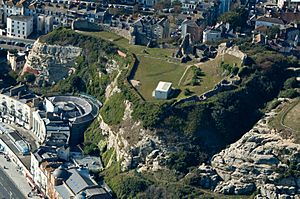
Hastings Castle was built in 1070 by the Normans. It stands on West Hill, looking over the town centre. It's a very important historic building. Not much of the castle remains today, just parts of the walls, dungeons, and an arch from the chapel.
The nearby St. Clements Caves are home to the Smugglers Adventure. This attraction has interactive displays about the history of smuggling on the south coast.
Hastings Pier can be seen from anywhere along the seafront. The old pier opened in 1872. It closed in 2006 due to safety concerns. In October 2010, a big fire destroyed most of its buildings. However, the pier reopened on April 27, 2016, after a £14.2 million renovation. It won a major architecture award, the Stirling Prize, in 2017.
Many churches in Hastings are also important historic buildings. These include Church in the Wood and the Hastings Fishermen's Museum (which used to be a church).
On the seafront in St Leonards is Marine Court. This 1938 block of flats is in the Art Deco style. It was originally called 'The Ship' because it looked like the ocean liner RMS Queen Mary. You can see this building from up to 20 miles away on a clear day.
An important old landmark was "the Memorial." This clock tower honored Albert the Prince Consort. It stood in the town centre for many years. But it was taken down in the 1970s after a fire.
Getting Around Hastings
Road Travel in Hastings
Hastings is the largest urban area in Britain without a direct dual-carriageway road to the main motorway network. The two main roads are the A21 to London and the A259 coastal road. Both often have traffic problems. The A21 has been widened in places, but delays still happen. Plans for a better A259 were stopped in the 1990s.
A new road, the A2690, opened in April 2016. It links Queensway in Hastings to the A259 in Bexhill. This road aims to reduce traffic on the A259 Bexhill Road. Hastings is also linked to Battle by the A2100, which was the original London road.
Stagecoach South East buses serve the town. They also go to Bexhill, Eastbourne, and Dover. Stagecoach also runs longer-distance buses to places like Royal Tunbridge Wells and Canterbury.
National Express runs a bus service to London.
National Rail Connections
Hastings has four rail links. Two go to London, one to Brighton, and one to Ashford. The shorter London route is the Hastings Line to Charing Cross. It opened in 1852. The longer London route is the East Coastway Line to Victoria. Trains to Brighton also use the East Coastway Line.
The Marshlink Line goes to Ashford. From there, you can connect to Eurostar services.
Southeastern and Southern are the two train companies serving Hastings. Southeastern runs services on the Hastings Line. Southern serves the other lines.
Hastings has four railway stations: West St Leonards, St Leonards Warrior Square, Hastings, and Ore. There was also a station called West Marina, which closed in 1967. A new station is planned at Glyne Gap in Bexhill.
Local Rail and Paths
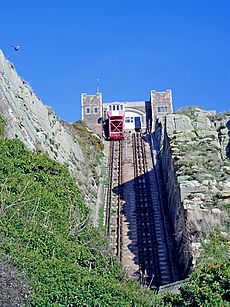
Hastings has two funicular railways, known as the West Hill and East Hill Lifts. These are like small trains that go up and down steep hills.
The Hastings Miniature Railway runs along the beach. It goes from Rock-a-Nore to Marine Parade. This railway has been carrying tourists since 1948. It was greatly restored and reopened in 2010.
The Saxon Shore Way is a long walking path. It's 163 miles long and follows the Kent and Sussex coast. It traces the coastline as it was in Roman times, ending in Hastings. The National Cycle Network route NCR2 also passes through Hastings. This route links Dover to St Austell along the south coast.
Past Transport Systems
In 1753, important people in Hastings got permission to control the road to London. This was the first step towards a proper turnpike road in the area. The route is now the A21.
Hastings had a network of trams from 1905 to 1929. The trams went as far as Bexhill. They were powered by overhead electric wires. Later, Trolleybuses replaced the trams in 1928–1929. These trolleybuses were then replaced by diesel buses in 1959.
Education in Hastings
Hastings has 18 primary schools and four secondary schools. It also has one college for further education and one university.
The University of Brighton in Hastings offers university courses. It has over 800 students. The university's Hastings campus grew in 2012 with a new building.
Sussex Coast College is the town's further education college. It is located at Station Plaza, next to the railway station.
The secondary schools are Ark Alexandra Academy, Hastings Academy, and The St Leonards Academy. Three older schools were closed and replaced by these two new academy schools.
Religious Buildings
The most important old buildings from the late medieval period are two churches in the Old Town. These are St Clement's (built after 1377) and All Saints (early 1400s).
There is also a mosque in Hastings. It used to be a school. The former Ebenezer Particular Baptist Chapel in the Old Town dates from 1817. Christ Church, Blacklands (1876), has beautiful decorations.
Healthcare Services
Over the years, healthcare in Hastings was provided by several hospitals. These included the Royal East Sussex Hospital and St Helen's Hospital. In 1993, all hospital services were brought together at the Conquest Hospital.
Sports and Activities
Every year, the Hastings Half Marathon takes place in the town. This 13.1-mile (21.1 km) race started in 1984. It attracts runners from all over the country. The race starts and finishes near the West Marina Gardens in St Leonards.
Hastings United F.C. is the town's oldest football team. They play in the Premier Division of the Isthmian League. The club was founded in 1894. They play their home games at The Pilot Field. In 2013, they reached the third round of the FA Cup for the first time.
The Central Recreation Ground was a very old and famous cricket ground. Matches were played there from 1864 to 1989. The site is now a shopping centre. Hastings Priory is the town's largest cricket club. They have four teams and a big junior section.
South Saxons Hockey Club was founded in 1895. It is the town's only field hockey club. They play at Horntye Park. They have nine Saturday teams and a growing junior section.
Hastings Conquerors is an American Football Club. It was started in 2013. It is the UK's first not-for-profit American Football club run as a co-operative.
There are many bowling greens in the town's parks. The Hastings Open Bowls Tournament has been held every June since 1911.
Since 1920, Hastings has hosted the Hastings International Chess Congress. This annual event takes place over Christmas. Many famous chess players have played there. Almost every World Champion before Garry Kasparov has played at Hastings.
Hastings has hosted the World Crazy Golf Championships since 2003.
Famous People from Hastings
- John Logie Baird, who helped invent television, lived in Hastings in the 1920s.
- Robert Tressell wrote his famous book The Ragged Trousered Philanthropists in Hastings.
- Novelist Catherine Cookson lived in the town for many years. She started writing after joining a local writing group.
- Many notable people were born, grew up, or lived in Hastings. These include computer scientist Alan Turing, comedian Jo Brand, and Madness singer Suggs.
- Gareth Barry, who holds the record for most appearances in the Premier League, was born in Hastings.
- Archibald Belaney, the author known as Grey Owl, was born in Hastings.
- Harry H Corbett, an actor famous for Steptoe and Son, lived in Hastings.
- Mark Edwards, a best-selling writer, grew up in Hastings.
- Anna Brassey, a collector and early photography pioneer, was based in Hastings.
- Tom Chaplin, lead singer of the band Keane, was born in Hastings.
- The punk rock band Maid of Ace is from Hastings.
- Cartoonist Martin Honeysett lived in Hastings for many years.
- Writer Roger Lewis lives in the town.
Hastings in Films and TV
Film Appearances
- Shadow of a Man (1956)
- The Canterbury Tales (1972)
- I Want You (1998)
- Grey Owl (1999)
- Some Voices (2000)
- The Final Curtain (2000)
- Another Life (2001)
- When I Was 12 (2001)
- Byzantium (2013)
- The Great Escaper (2023)
Television Shows Set in Hastings
- Buddy (1986)
- Foyle's War (2002–15)
- Roadkill (TV series) (2020)
- Giri/Haji TV series (2019)
- Close to Me (2021)
Twin Towns Around the World
Hastings is twinned with these towns:
- Béthune, France
- Oudenaarde, Belgium
- Schwerte, Germany
- Dordrecht, Netherlands
- Hastings, Sierra Leone
Images for kids
See also
 In Spanish: Hastings para niños
In Spanish: Hastings para niños




